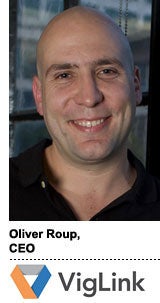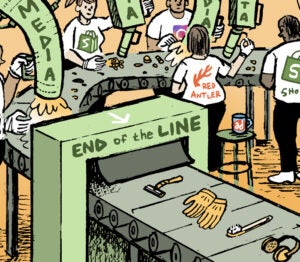 “Affiliate marketing has gone much more mainstream,” says VigLink CEO Oliver Roup. That’s his hope, at the very least, since his 28-person company is built on the commission-based lead gen business model that has been a cornerstone of web marketing.
“Affiliate marketing has gone much more mainstream,” says VigLink CEO Oliver Roup. That’s his hope, at the very least, since his 28-person company is built on the commission-based lead gen business model that has been a cornerstone of web marketing.
Roup adds, “[Affiliate marketing] has gone from coupons to content. Though coupon sites were dominating up until a few years ago, what you’ve seen since that time is mainstream publishers, who deal in real content are starting to delve into the affiliate world.” Huffington Post and Wanelo are among the larger media companies using VigLink products today which, he asserts, “proves” that affiliate marketing is less on the fringes than ever.
And with Q4 2012 year-over-year revenue growth of 118% according to Roup, VigLink wants to continue to scale. Bigger sites mean more inventory, which leads to more potential leads and more revenue to affiliate marketers, VigLink publishers – and VigLink itself. And it all begins with the use of the innocent text hyperlink: when a sale is consummated, upstream credit is assigned to VigLink publishers along the clickstream who originally sent the traffic.
AdExchanger spoke to VigLink CEO Oliver Roup last week about his company and industry trends.
AdExchanger: Is “affiliate marketing” still the right label for what you do today?
OLIVER ROUP: I think content monetization or native monetization is a more appropriate label. If you check our website, we use the word “affiliate” sparingly. Some people identify as an “affiliate” and we still want to talk to them, but for the most part, we don’t use those words.
As part of that transition to the mainstream, people are stepping away from words that have had poor connotations and are moving towards “content monetization” or “content-driven commerce” – that’s a phrase we use a lot.
Since we last spoke in March 2011, how has the VigLink product set evolved, and how do you see that as a reflection of the market moving?
Since the last time we spoke, we have expanded to three products: VigLink Convert, VigLink Insert and VigLink Anywhere. Two years ago, we only had VigLink Convert, which we used to call link affiliation – in other words, links in content transparently being turned into the affiliate or monetized versions of themselves. That product has continued to grow and includes 30,000 merchants and advertisers who participate. We do billions of page views a month and millions a month in revenue.
Since then, we’ve launched a new product called VigLink Insert, which is NLP-driven (NLP is Natural Language Processing) link insertion product where, if a publisher turns it on, we can insert new links in the content that are pointing to merchants. We released some stats about it recently. The click-through rate on those inserted links in June 2012 was 0.86%, which is pretty good. But in February 2013, it rose to 1.35%. We’re very proud of that number. In the same period, average earnings for Inserts climbed, too.
Advertisers like it because it’s very clearly incremental revenue. It expands our customer base. We’re not just looking for publishers who already have links to merchants. Really, anyone can turn on VigLink Insert.
AdExchanger Daily
Get our editors’ roundup delivered to your inbox every weekday.
Daily Roundup
The last product is VigLink Anywhere. Think of it like a link shortener so you can share links on Twitter, Facebook, or all the various social media channels. Those links are optimized by VigLink to be revenue-bearing.
Any plans or anything you’re doing today with the data VigLink sees, beyond the remuneration of publishers for an affiliate transaction?
We definitely have plans. We think there’s a lot of opportunity there. Certainly, improving insertion is one factor of that. Stay tuned.
If you think about us as a network, we’re a fairly large network. Today, what we do is we sell the click itself, and we do believe there’s an opportunity to sell the knowledge that the click occurred.
Regarding the “view-through,” is there value in your opinion or does VigLink only provide compensation on a click? In other words, does “the view” count?
First, as a practical matter, most merchants do have a lifetime on their cookies. I believe eBay has seven days. If you click through a VigLink link to eBay, don’t purchase anything, then come back in three days and buy something, the VigLink publisher will get credit for that purchase. That is what you call a “last click wins” scenario.
But we suspect that coupon sites intercept a lot of the value that our publishers are creating and that the coupon site gets the credit. At this point, publishers are not compensated for any click other than the last one. We are working to try and understand that more deeply. Ideally, we would like to compute that value and be able to deliver as promised to the publisher. I wouldn’t say we’re there yet. We are doing some fairly detailed experiments with some merchants though.
Are your publisher clients mainly long-tail? Is there interest from the so-called “premium” or large publisher side these days?
It’s all over the map. As I’ve mentioned, we have sites like Huffington Post and Wanelo which are very mainstream, but then we have plenty of “tail” and “torso” sites.
An interesting piece of data we see about large publishers who make their living with the display world is very different than what many might expect. There is a perception that “premium” commands a premium and “tail” sites don’t command anything. We see the opposite. Sites that, in the display world, are considered “premium,” when you look at it on a conversion basis, we would describe them as poor quality. And then these tail sites that don’t get any respect from display convert like mad. And so, that’s been part of our success when we approach these mid- and long-tail sites. They’re being ignored and mistreated by the display world. When we come in, they’re excited to hear from us.
On the buy side or merchant side, who’s right for VigLink today?
Today, we work with largely all the affiliate networks out there. And so, advertisers who have affiliate programs, we work with them and we have direct relationships. But the way we view this is that we are click sellers and looking for a click buyer. The advertisers who work with affiliate networks will certainly be the easiest buyers to sign up because most of the work has been done, and they emotionally understand that they want to buy traffic on a conversion basis. But it’s a much larger universe of potential buyers in that.
Regarding today’s privacy discussions around online behavioral advertising, would blocking third-party cookies significantly impact affiliate marketing in your opinion?
There may be some short-term impact. Third-party cookies are currently the technical means by which the tracking is done, but there are certainly other technical means that still get done what needs to get done and don’t use privacy-invasive business models. And so I think it would be an inconvenience, but not a showstopper.
Looking out a year or two, what are some milestones you’d like to have VigLink accomplish?
Certainly, there are milestones around growth and coverage of international. We’ve been growing at a very fast pace and, financially, it’s a more interesting and viable business. We’re excited to continue to accelerate. A couple of years ago, what we’re doing was fairly fringe. Today, it’s pretty mainstream. I’d like to continue to see that progress.
Follow Oliver Roup (@oroup), VigLink (@VigLink) and AdExchanger (@AdExchanger) on Twitter.













